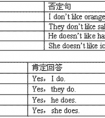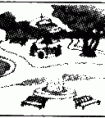看图补全句子。1. I like __________, and I like __________.2. I like __________, __________ I don'tlike __________.3. I like __________, __________ I don't-四年级英语
例如:leaf (树叶,叶子),half (一半),self (自已),wife (妻子),knife (刀子),shelf (架子),wolf (狼), thief (窃贼,强盗) 和 life (生命),
这些名词变成复数时,都要改 -f (e) 为 v,再加 -es。
3. -f 结尾的名词直接加 -s 变复数歌诀:海湾边、屋顶上,首领奴仆两相望;谁说他们无信仰,证据写在手帕上。
例如:gulf, roof, chief, serf, belief, proof, handkerchief,这些名词变复数直接加 -s。
注:scarf(围巾;披风) 可以先改 f 为 ve 再加-s,也可直接加 -s。
4. 辅音字母 + y 结尾的名词,把 y 变 i 加 -es。
例如:baby → babies, country → countries, family → families;而 -y 前是元音时,-y 不变,直接加 -s。例如:day → days, boy → boys
5. 以 -o 结尾的名词变复数时,多数直接加 -s。
例如:radio → radios, piano → pianos, kangaroo → kangaroos;有的须加 -es,中学课本中有几个这样的单词,可以通过一句口诀来记忆:黑人英雄爱吃西红柿和土豆。
即:Negro → Negroes, hero → heroes, tomato → tomatoes, potato → potatoes;有的以 o 结尾的名词既可加 -s 也可加 -es。
例如:volcano (火山) → volcanos / volcanoes 等。
6. 名词复数的不规则变化需要特别记忆。
例如:man → men, woman → women, goose → geese, foot → feet, tooth → teeth, mouse → mice, louse (虱子) → lice, child → children, fish → fish, deer (鹿) → deer, sheep → sheep 等。
7. 初中课本中表示“某国人”的名词复数形式变化可通过歌诀记忆:中日不变英法变,其余 -s 加后面。
例如:Chinese → Chinese, Japanese → Japanese;
Englishman → Englishmen, Englishwoman → Englishwomen, Frenchman → Frenchmen, Frenchwoman → Frenchwomen;
American → Americans, Rusian → Rusians, Arab → Arabs, German → Germans 等。
8. 不可数名词一般只有单数形式,没有复数形式。有些不可数名词可借助单位词表示一定的数量。
例如:a cup of tea 一杯茶
, two piece of paper 两张纸, an item of news 一则新闻
考点名称:连词
- 连词:
是连接单词、短语或句子的一种词,连词不能独立担任句子成份,而只起连接作用。
连词可分为两大类:并列连词和从属连词。 - 连词的用法:
一、并列连词:
1.and连接单词MybrotherandIstudyinthesameschool。
连接短语Ourknowledgemaycomefromthebooksandfrompractice。
连接句子Wearesingingandtheyaredancing。
2but但是/而是Ihaveapenbutnopencil.or或者Willyougotherebybusoronfoot
3.nothingbut除了,只有Ididnothingbutwatchit。
4.or表示否则Hurryuporyouwillbelate。
5.for表示因为Heisgoodatmathforhestudiesharderthanothers。
二、从属连词:
1.after表示“时间”,在…之后
AfterIfinishedtheschool,Ibecameaworkerinthefactory。
2.although/though表示让步,“尽管”Althoughsheisyoung,sheknowsalot。
3.as表示时间,“当…时”,方式“象…”,原因,“由于、因为”让步,“尽管、虽然”
Asitwaslate,wemustgonow。
4.asif/asthough表方式,“似乎、好像”
Hetoldissuchastoryasthoughhehadbeentherebefore。
5.aslongas/solongas表条件,“只要”AslongasIamfree,I’llgotohelpyou。
6.assoonas表时间,“一…就…”IwillphoneyouassoonasIcomeback。
7.because表原因,“因为”IhavetostayinbedbecauseIamill。
8.before表时间,“在…之前“Youshouldthinkmorebeforeyoudoit。 比较and和or
①并列结构中,or通常用于否定句,and用于肯定句。
②但有时and 也可用于否定句。请注意其不同特点:
There is no air or water in the moon.
There is no air and no water on the moon.
在否定中并列结构用or 连接,但含有两个否定词的句子实际被看作是肯定结构,因此要用and。
比较so和 such
其规律由so与such的不同词性决定。
such 是形容词,修饰名词或名词词组;
so是副词,只能修饰形容词或副词;
so 还可与表示数量的形容词many,few,much, little连用,形成固定搭配。
so + adj. such + a(n) + n.
so + adj. + a(n) + n. such + n. (pl.)
so + adj. + n. (pl.) such +n. (pl.)
so + adj. + n. [不可数] such +n. [不可数]
so foolish such a fool
so nice a flower such a nice flower
so many/ few flowers such nice flowers
so much/little money. such rapid progress
so many people such a lot of people
so many 已成固定搭配,a lot of 虽相当于 many,但 a lot of 为名词性的,只能用such搭配。
so…that与such…that之间的转换既为 so与such之间的转换。- 小学阶段常见的连词:
(1)and(和)表示并列和对称
例:I like basketball and football. 我喜欢篮球和足球。
She likes singing and dancing. 她喜欢唱歌和跳舞。
(2)or(或者,还是)表示选择。(常出现在选择疑问句中)
例:Is it big or small?
(3)if(如果……)表示条件。
例:We will go to the zoo if it does not rain tomorrow. 如果明天不下雨,我们就去动物园。
(4)because(因为……)表示原因。
例:John doesn’t come to school today because he is ill. 约翰今天没来上学,因为他病了。
Li Lei was late for class because he got up late. 李雷上课迟到了,因为他起床迟了。
(5)but(但是)表示转折。
例:The skirt is nice, but it’s too expensive. 这条裙子很漂亮,但是太贵了。
(6)for(因为)表示原因。
例:He must be at home now, for it’s raining. 他现在一定在家,因为正在下雨。
(7)so(因此、所以)表示原因。
例:He got up late, so he missed the train. 他起床晚了,因此错过了火车。
- 最新内容
- 相关内容
- 网友推荐
- 图文推荐
| [家长教育] 孩子为什么会和父母感情疏离? (2019-07-14) |
| [教师分享] 给远方姐姐的一封信 (2018-11-07) |
| [教师分享] 伸缩门 (2018-11-07) |
| [教师分享] 回家乡 (2018-11-07) |
| [教师分享] 是风味也是人间 (2018-11-07) |
| [教师分享] 一句格言的启示 (2018-11-07) |
| [教师分享] 无规矩不成方圆 (2018-11-07) |
| [教师分享] 第十届全国教育名家论坛有感(二) (2018-11-07) |
| [教师分享] 贪玩的小狗 (2018-11-07) |
| [教师分享] 未命名文章 (2018-11-07) |






